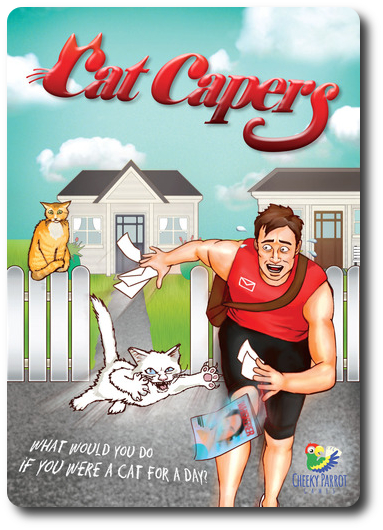
The Basics:
- For ages 8 and up
- For 2 to 4 players
- Approximately 20 minutes to complete
Geek Skills:
- Counting & Math
- Logical & Critical Decision Making
- Reading
- Pattern/Color Matching
- Strategy & Tactics
- Risk vs. Reward
- Hand/Resource Management
- Bluffing and Misdirection
- Worker Placement & Area Control
Learning Curve:
- Child – Easy
- Adult – Easy
Theme & Narrative:
- While the people are away, the cats will play
Endorsements:
- Gamer Geek rejected!
- Parent Geek mixed!
- Child Geek approved!
Overview
Upon casual observance, the life of a cat would appear to be dull. The most a cat can hope for is a warm sunbeam and a high perch to lazily observe their domain. In truth, cats have exciting lives full of hunting, combat, comradery, and jovial fun. It’s what people don’t observe that is the most interesting. Join a cat on their adventures to see just how exciting a feline’s life can be!
Cat Capers, designed by Claire Ahuriri, James Dunning and published by Cheeky Parrot Games, is comprised of 4 House boards, 4 Player screens, 4 Paw Placement trackers, 16 Cat Paw tokens (4 per player), 36 Cat cards, 26 Activity cards, 4 Player Aid cards, and 1 First Player marker (with plastic base). The game comes an expansion, as well, that adds 4 Rex Paws tokens. All of the game components are of excellent quality, with the House, tokens, and trackers being made of thick cardboard and the cards as thick and as durable as your standard playing card.
Another Morning, Another Meow
To set up the game, first give each player 1 Player screen, 1 Paw Placement tracker, 4 Cat Paw tokens, and 1 Player Aid card all of the same color (red, yellow, green, and blue, respectively). Place any not used back in the game box. Each player places the Player screen in front of them now. The Paw Placement tracker and Cat Paw tokens are placed behind the Player screen, out of view from the player’s opponents. Flip the Paw Placement tracker to the proper side, face-up, based on the number of players.

Each Player screen has a short description of the cat and a reminder of how to earn more points
Second, arrange the House boards in a row in the middle of the playing area. I suggest you arrange them in the order shown on the Paw Placement trackers to make it easy to visually match specific House boards to the house images on the Paw Placement tracker.
Third, shuffle the Activity cards and deal a pile of 6 face-down Activity cards above each House board. Any remaining Activity cards are placed face-down in a pile off to one side of the game playing area. This pile is referred to as the “Leftovers”.
Fourth, shuffle the Cat cards and deal each player 4, face-down. This is the player’s starting hand of cards which should be kept hidden from their opponents until played. Place the remaining Cat cards face-down to the middle of the playing area to create the Cat draw deck.
That’s it for game set up. Determine who will go first and hand them the First Player marker.
Paw-Some Cat-Titude
Cat Capers is played in 6 rounds. Each round consists of 5 phases wherein all players take part. A game round is summarized here.
Phase 1: Reveal Activity Cards
The top-most Activity card in the piles above each House board are drawn and revealed. Activity cards display a point value or a “Draw Card” symbol. The Activity cards represent the shenanigans the player’s cat can have at each of the houses on the block.
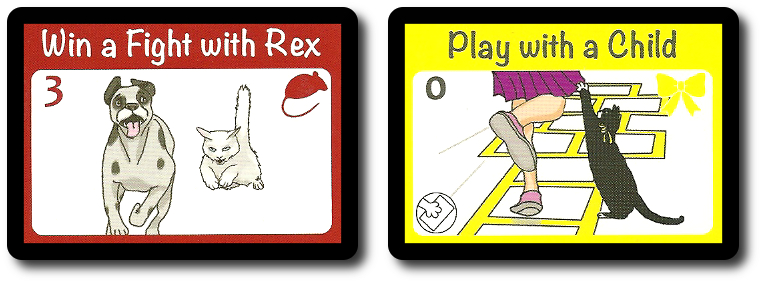
Phase 2: Allocate Paws
Each player now takes their Paw Placement tracker and assigns their Cat Paw tokens to any of the house images that correspond to the House boards or to the image of a sleeping cat in a basket.
Assigning Cat Paw tokens to a house image means the player will be competing for the Activity card currently assigned to that house. Before the player decides to pursue the Activity card, they should take note of how many points the card is worth and its color. If the Activity card matches the player’s Player screen color (the color that represents the cat), the Activity card is worth one more point than listed. If colors are difficult to view, each Activity card (and Cat card) has a symbol that can be used instead.
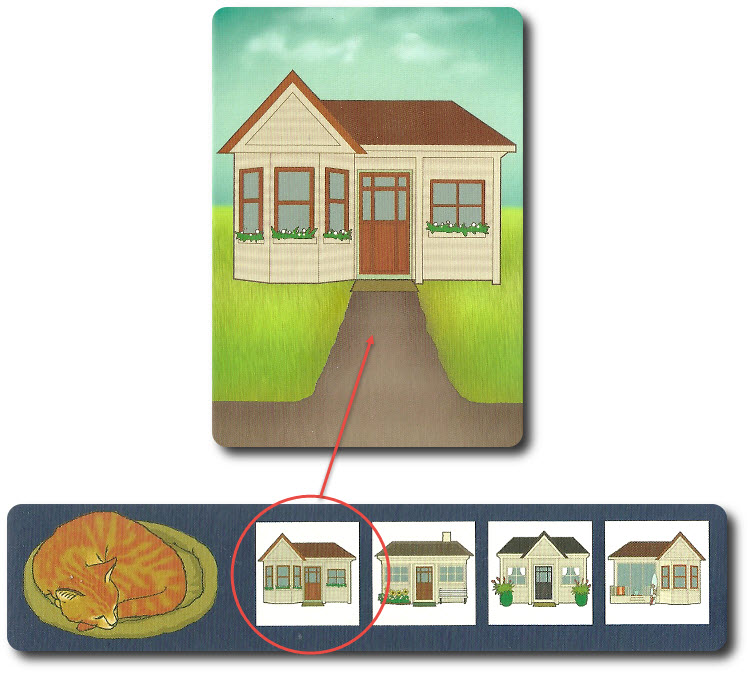
Assigning Cat Paw tokens to the sleeping cat will allow the player to draw bonus Cat cards at the end of the round.
Phase 3: Reveal and Place Paws
Once every player has finished placing their Cat Paw tokens, the Player screens are lifted and the Cat Paws are moved to the matching House boards. Any Cat Paw tokens on the sleeping cat remain.
Phase 4: Resolve Challenges
Each House board is now resolved in turn, starting with the left-most House board. If there are no Cat Paw tokens on the House board, the Activity card above it is discarded. If only 1 player placed Cat Paw token, the player removes their tokens and takes the Activity card. Activity cards are placed face-down behind the Player screen.
In all other cases, where two or more players have placed Cat Paw tokens to the same house, a challenge ensues. In turn order sequence, starting with the First Player for the round, each player who is competing for the Activity card can do 1 of the following actions:
- Play 1 Cat Card Face-Up: Cat cards provide an effect that will give the player a bonus or their opponent a penalty. The played Cat card must match the color and symbol of the Activity card being fought over (with the exception of grey colored cards). In almost all cases, only those players involved in the challenge can play Cat cards. The one exception is the “Disdain” Cat card that can be played by any player to cancel a previously played Cat card.
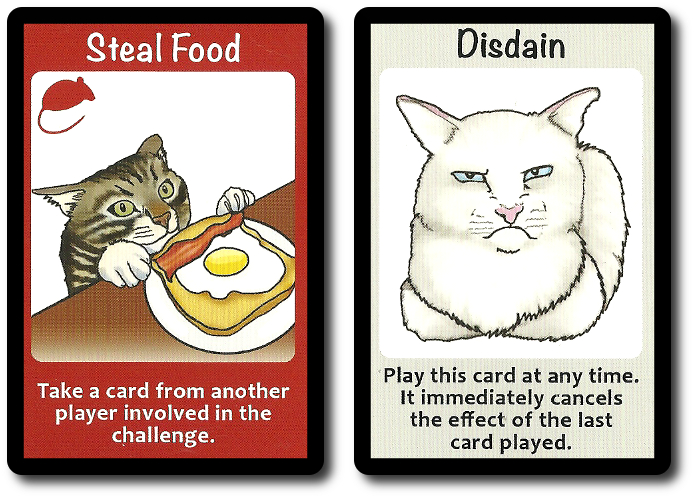
- Play 1 Cat Card Face-Down: Cat cards played face-down provide a bonus of +1 Paw to the player’s total Cat Paw tokens on the House board. Since the Cat card is face-down, the color need not match the Activity card.
- Pass: This option allows the player to not use a Cat card on their turn, but they are not out of the challenge. They can select another action when it’s again their turn.
- Withdraw: If the competition is getting too intense or the player decides the Activity card is not worth it, they can bow out of the challenge, removing their Cat Paw tokens and any claim to the Activity card.
After the players have finished a round challenging each other, a new round begins. This continues until only 1 player is left who can claim the Activity card. If a player ever loses all their Cat Paws on a House board, they are automatically withdrawn from the challenge.
A challenge can also end if a player uses the “Rex” Cat card. This cancels the challenge and removes the Activity card from play.
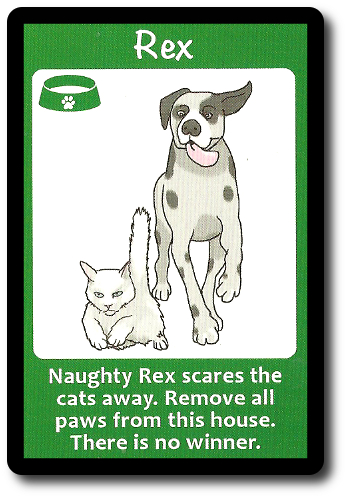
Phase 5: Draw Cards and Pass First Player Marker
All played Cat cards are now discarded and new Cat cards are drawn. Any player who placed Cat Paw tokens to the sleeping cat on their Paw Placement trackers gets to draw 1 Cat card per token. Then each player draws 1 Cat card, ensuring that each player has at least 1 Cat card for the next round. If the player won an Activity card that had the “Draw Card” symbol, they draw the top-most Activity card from the Leftovers pile and add it to their other Activity cards behind their Player screen.
This ends the round. The First Player marker is passed to the next player in turn order sequence and a new round begins.
Purr-Fect Victory
The game continues as described above and ends when the 6th round is completed. Each player now reveals their collected Activity cards and adds the point values listed, making sure to give themselves a +1 bonus point for every Activity card that matches their cat’s color. The player with the most points wins the game.
Good Boy, Rex
Rex is a dog who does not care for cats. During the game set up, each player is given Rex Paw tokens to use when assigning tokens to houses. Rex Paw tokens are used to force a challenge upon an opponent and make it difficult to obtain Activity cards. A player need only have more Cat Paw tokens than Rex Paw tokens to win, but until they have the majority, they must spend Cat cards or withdraw.
To learn more about Cat Capers, visit the game’s website.
Final Word
The Child Geeks enjoyed the game a great deal. They didn’t care for the cat names (especially the boys), but they found nothing disagreeable regarding the game play. According to one Child Geek, “I like how you have to guess which house will not be competed over, but sometimes you just have to go for it.” The Child Geeks learned that spreading themselves too thin across multiple House boards could result in no points earned and putting all your paws in one spot was still not a sure-thing. As one Child Geek put it, “You have to consider what your opponents will do based on their color and how much you are willing to risk to earn points. I really like it.” The risk versus reward game play elements was found to be very satisfying and rewarding, which provided both cheers and groans during each round. When the games were over, all the Child Geeks voted to approve Cat Capers.
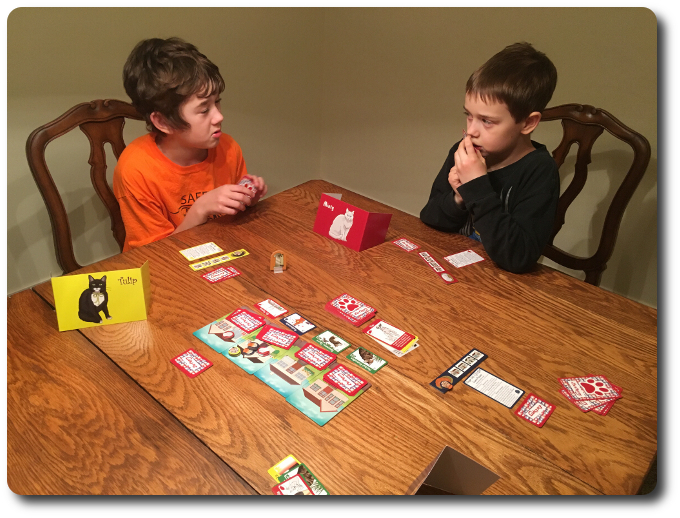
Two cool cats battle it out for an Activity card, each eyeing the other suspiciously
The Parent Geeks enjoyed the game, but the intensity of their enjoyment was determined by their overall experience level and who they had available to play the game with. According to one Parent Geek, “As a casual gamer, I’m really enjoying this. It has a lot of the game play that I look for, but I only find in larger games that I don’t want to play.” Another Parent Geek said, “The game is a perfect mix of many of things I like about other games, but it’s done very casually making it light and fun.” Not all Parent Geeks felt the game was praise worthy. According to one Parent Geek, “Oh, it’s a good game, but it is too light for me and my usual group of players. We might play it as a filler, but we’ll jump to something else pretty quick.” And finally, another Parent Geek said, “Unless I’m playing with my kids, I don’t think I’d want to play this game.” When the votes were in, the Parent Geeks gave Cat Capers a mixed level of approval.
The Gamer Geeks recognized many of the game play elements immediately, praising the game designers for making what they believed to be a solid game. According to one Gamer Geek, “Despite how I might feel about the game personally, I have to say it is well made and well designed.” But that did not save it from the critical eye of the Gamer Geeks. The elitists found the game to be too light and too casual, lacking the type of strategic and tactical depth they hunt for. As one Gamer Geek put it, “Great game for kids, casual players, and others who don’t know a thing about games. For everyone else, they will be bored.” When the last cat was put outside, the Gamer Geeks voted to reject Cat Capers.
Cat Capers has all the makings of a game that would please more skilled and elitist gamers, but falls short. I believe this to be due to the game’s attempt to have one foot firmly in the child and family game arena and one foot in the casual gamers arena. It’s possible, but Cat Capers fell short of achieving this goal. The reason for this is due to its light nature and game play. Which is absolutely necessary if you are to appeal to the casual gamers and Child Geeks. It’s a conundrum that many game designers and publishers face. How can you be all things to all people? You cannot, as is the case with Cat Capers.
But instead of focusing on what the game is not, let us instead observe what it is. The simultaneous action selection and blind bidding is very well executed. Each round feels fresh and the reveal is rewarding. Challenges for Activity cards can be highly competitive and the outcomes can be surprising. Since points are always hidden, there is a constant feeling of anticipation and doubt that permeates the game’s atmosphere in a surprisingly positive way. It drives the player to take risks and to attempt to out wit their opponents.
Thematically speaking, you don’t have to be a cat lover to enjoy Cat Capers. Nor do I think it will help your game play to be so. It will, however, increase your enjoyment. While I would not count myself as a “cat hater” (what a silly thing to be labeled), I don’t particularly have any interest in cats, other than Battle Cat, of course. Throughout all our games, the theme bored me. Never to a point where it soiled the game play, but it was obvious to me that I was keeping the game at arm’s length. Which is to say, I never really got into. My attention was always on the game play and not the game as a whole. That’s difficult to understand if you have never experienced it yourself. It’s the opposite of thinking that something looks fantastic on the outside but is hollow on the inside. Cat Capers has a lot going on in the game, but the game’s presentation and theme was uninteresting to me.
Which is highly subjective, I must add. Other players who did enjoy cats and even those who did not overly care for them enjoyed the game. In all cases, what determined a player’s interest was not the cats it portrayed, but the game play it provided. Honestly, I can think of no better way to judge a game.
Cat Capers has enough filling to make you believe a gamer will enjoy it, but it falls short of delivery enough to satisfy true enthusiasts. For those players looking for a casual game with all the elements of a more difficult game, then Cat Capers will most certainly please. What it offers is complexity and challenge in a way that is easy to understand and rewarding. A great choice for those looking to enjoy a lighter game with family and friends. Do take a closer look at Cat Capers if you think it sounds purr-ty claw-some*.
This game was given to Father Geek as a review copy. Father Geek was not paid, bribed, wined, dined, or threatened in vain hopes of influencing this review. Such is the statuesque and legendary integrity of Father Geek.
*Sorry…



